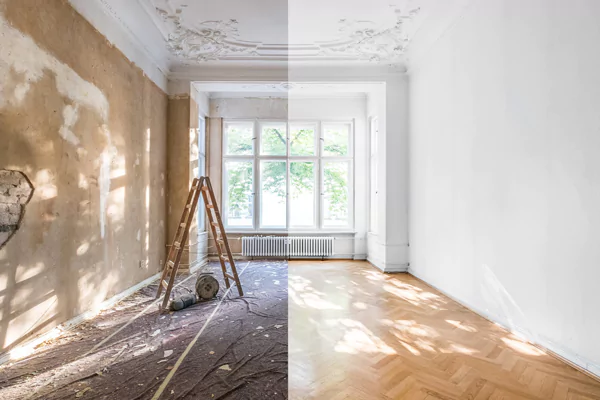How to Use Sustainable Materials in Your 2025 Home Renovation


As sustainability becomes a key focus for homeowners, 2025 is set to be the year of eco-friendly renovations. Homeowners are increasingly opting for materials that not only reduce their carbon footprint but also contribute to healthier, more efficient living spaces. Whether you’re renovating a single room or undertaking a larger project, choosing sustainable materials is an excellent way to create a beautiful, environmentally responsible home.
In this blog, we’ll explore how you can incorporate sustainable materials into your home renovation in 2025, from flooring to wall finishes to furniture and why you should choose interior designer chester to help with your next renovation project.
1. Start with Sustainable Flooring Options
Flooring is one of the most prominent features in any renovation, and choosing sustainable options for this crucial element can make a significant impact. Here are a few eco-friendly materials to consider for your flooring:
- Bamboo: Known for its rapid growth and durability, bamboo is a sustainable alternative to hardwood. It’s naturally resistant to pests, making it ideal for high-traffic areas and various climates.
- Cork: Made from the bark of cork oak trees, cork is a renewable resource that’s biodegradable and recyclable. It’s soft underfoot, making it perfect for living rooms, bedrooms, and even kitchens.
- Recycled Wood: Salvaged wood from old buildings, fences, or furniture can be repurposed into beautiful, unique flooring. Not only does it reduce the demand for new timber, but it also adds character to your space.
- Linoleum: Made from natural materials such as linseed oil, cork powder, and wood flour, linoleum is an eco-friendly alternative to vinyl. It’s durable, easy to maintain, and available in a variety of colors and styles.
Tip: Choose low-VOC (volatile organic compounds) finishes to ensure that your flooring is not only eco-friendly but also safe for indoor air quality.
2. Eco-Friendly Paints and Wall Treatments
When it comes to your walls, opting for non-toxic and sustainable paints is an easy way to contribute to a healthier home environment. Traditional paints can release harmful chemicals, such as formaldehyde, which can contribute to indoor air pollution. Here’s how you can make a difference:
- Low-VOC or No-VOC Paints: These paints are free from volatile organic compounds (VOCs), which can be harmful to your health. They are available in a wide range of colors and finishes, and many brands now offer low-VOC and zero-VOC options.
- Recycled Paints: Some companies specialize in recycled paints made from leftover paints collected from households and businesses. These paints are often high-quality and come in a variety of shades.
- Natural Plaster or Clay: For a more rustic and natural look, consider using natural plaster or clay-based wall treatments. These materials are biodegradable, non-toxic, and help regulate indoor humidity, creating a healthier living environment.
Tip: In addition to sustainable paints, consider eco-friendly wall coverings such as recycled wallpaper or fabric-based wall panels for added texture and insulation.

3. Sustainable Countertops for Kitchen & Bathroom
Kitchens and bathrooms are high-traffic areas in the home, and choosing sustainable countertops not only boosts the aesthetic but also helps protect the environment. Here are some great eco-friendly options:
- Recycled Glass: Made from post-consumer glass, such as bottles or jars, recycled glass countertops are a durable and visually striking option. The reflective properties of the glass add a beautiful sparkle to any space.
- Reclaimed Wood: For a warm, organic feel, reclaimed wood countertops can add character to your kitchen or bathroom. These countertops are often made from salvaged wood beams or barn wood, giving them a unique, rustic charm.
- Concrete: Recycled and low-carbon concrete options are available, offering a modern, industrial look. It’s versatile, durable, and can be customized with recycled materials such as glass, shells, or metal.
- Bamboo: As with flooring, bamboo is an excellent choice for sustainable countertops. It’s incredibly durable, resistant to moisture, and available in a variety of finishes and styles.
Tip: Choose countertops that are easy to maintain and repair, as this can extend their lifespan and reduce the need for replacements.
4. Sustainable Furniture and Decor
When renovating your home, it’s easy to overlook the environmental impact of the furniture you choose. Fortunately, there are many sustainable furniture options available that are both stylish and eco-friendly:
- Reclaimed Wood Furniture: Like reclaimed wood flooring, furniture made from salvaged wood reduces the need for new lumber. Each piece has a unique story and adds character to your space.
- Upcycled and Vintage Furniture: Upcycling old furniture is one of the most sustainable choices you can make. With a little creativity, you can give old pieces a new life, whether by painting, reupholstering, or simply restoring them.
- Furniture Made from Sustainable Materials: Look for furniture made from sustainably harvested wood, cork, or bamboo. Additionally, furniture made from organic fabrics such as hemp, organic cotton, or linen is a great choice.
Tip: Invest in quality pieces that are built to last, as this reduces the need for frequent replacements.
5. Sustainable Lighting Solutions
Lighting can have a significant impact on your home’s energy efficiency. Choosing energy-efficient and eco-friendly lighting options will help you reduce your carbon footprint and save on electricity bills.
- LED Lights: LED bulbs use significantly less energy than traditional incandescent bulbs, and they last longer. Look for LED lighting solutions that are dimmable to save even more energy.
- Solar-Powered Lighting: For outdoor spaces, consider using solar-powered lights. These lights use energy from the sun, reducing your need for electricity and helping you maintain an eco-friendly home.
- Energy-Efficient Fixtures: Opt for light fixtures that use sustainable materials such as bamboo, recycled metals, or glass, and ensure that the fixtures are designed to minimize energy consumption.
Tip: To enhance energy efficiency, use natural light wherever possible. Consider installing larger windows or skylights to allow more daylight into your home.
6. Green Building Practices for Structural Elements
When renovating, consider incorporating green building practices into your home’s structural elements. These practices focus on reducing energy consumption and improving the efficiency of your space:
- Insulation Made from Recycled Materials: Insulation is critical for maintaining a comfortable indoor temperature, and using recycled materials such as cellulose (made from recycled paper) or cotton (from recycled denim) is an eco-friendly choice.
- Energy-Efficient Windows: Choose windows with low-emissivity (Low-E) coatings or double-glazing to improve insulation and reduce heating and cooling costs.
- Sustainable Roofing Materials: Consider eco-friendly roofing options such as metal roofing, which is highly durable and recyclable, or solar tiles that allow you to generate your own energy.
Tip: Partner with a contractor who specialises in green building practices to ensure that your renovation is as eco-friendly as possible.
Conclusion
Renovating your home with sustainable materials in 2025 is a powerful way to reduce your environmental impact while creating a healthier, more energy-efficient living space. By choosing eco-friendly flooring, paints, countertops, furniture, lighting, and building practices, you can transform your home into an environmentally responsible sanctuary. The key is to make thoughtful, informed choices and work with professionals who can help you navigate sustainable design options.
Ready to start your sustainable renovation journey? Hire professional interior designer north wales to help you!



